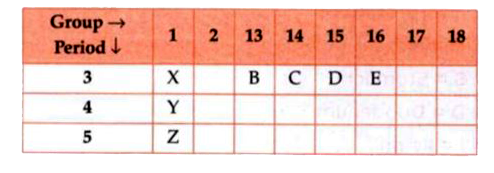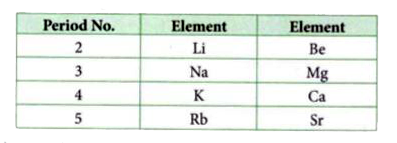Give the electronic configurations of the elements : .19K,.25Mn,.20Ca
To find the electronic configurations of the elements Potassium (K), Manganese (Mn), and Calcium (Ca), we will follow the Aufbau principle, which states that electrons fill atomic orbitals in order of increasing energy levels.
1. Potassium (K, atomic number 19):
- The atomic number indicates that potassium has 19 electrons.
- We fill the orbitals in the following order:
- 1s: 2 electrons → 1s²
- 2s: 2 electrons → 2s²
- 2p: 6 electrons → 2p⁶
- 3s: 2 electrons → 3s²
- 3p: 6 electrons → 3p⁶
- 4s: 1 electron → 4s¹ (since we have filled 18 electrons already, the 19th electron goes into the 4s orbital)
- Therefore, the electronic configuration of Potassium is:
K: 1s22s22p63s23p64s1
2. Manganese (Mn, atomic number 25):
- Manganese has 25 electrons.
- We fill the orbitals in the following order:
- 1s: 2 electrons → 1s²
- 2s: 2 electrons → 2s²
- 2p: 6 electrons → 2p⁶
- 3s: 2 electrons → 3s²
- 3p: 6 electrons → 3p⁶
- 4s: 2 electrons → 4s²
- 3d: 5 electrons → 3d⁵ (the remaining 5 electrons go into the 3d orbital)
- Therefore, the electronic configuration of Manganese is:
Mn: 1s22s22p63s23p64s23d5
3. Calcium (Ca, atomic number 20):
- Calcium has 20 electrons.
- We fill the orbitals in the following order:
- 1s: 2 electrons → 1s²
- 2s: 2 electrons → 2s²
- 2p: 6 electrons → 2p⁶
- 3s: 2 electrons → 3s²
- 3p: 6 electrons → 3p⁶
- 4s: 2 electrons → 4s² (the 20th electron goes into the 4s orbital)
- Therefore, the electronic configuration of Calcium is:
Ca: 1s22s22p63s23p64s2
Final Electronic Configurations:
- K: 1s22s22p63s23p64s1
- Mn: 1s22s22p63s23p64s23d5
- Ca: 1s22s22p63s23p64s2
- The atomic number indicates that potassium has 19 electrons.
- We fill the orbitals in the following order:
- 1s: 2 electrons → 1s²
- 2s: 2 electrons → 2s²
- 2p: 6 electrons → 2p⁶
- 3s: 2 electrons → 3s²
- 3p: 6 electrons → 3p⁶
- 4s: 1 electron → 4s¹ (since we have filled 18 electrons already, the 19th electron goes into the 4s orbital)
- Therefore, the electronic configuration of Potassium is:
K: 1s22s22p63s23p64s1
- Manganese has 25 electrons.
- We fill the orbitals in the following order:
- 1s: 2 electrons → 1s²
- 2s: 2 electrons → 2s²
- 2p: 6 electrons → 2p⁶
- 3s: 2 electrons → 3s²
- 3p: 6 electrons → 3p⁶
- 4s: 2 electrons → 4s²
- 3d: 5 electrons → 3d⁵ (the remaining 5 electrons go into the 3d orbital)
- Therefore, the electronic configuration of Manganese is:
Mn: 1s22s22p63s23p64s23d5
- Calcium has 20 electrons.
- We fill the orbitals in the following order:
- 1s: 2 electrons → 1s²
- 2s: 2 electrons → 2s²
- 2p: 6 electrons → 2p⁶
- 3s: 2 electrons → 3s²
- 3p: 6 electrons → 3p⁶
- 4s: 2 electrons → 4s² (the 20th electron goes into the 4s orbital)
- Therefore, the electronic configuration of Calcium is:
Ca: 1s22s22p63s23p64s2
- K: 1s22s22p63s23p64s1
- Mn: 1s22s22p63s23p64s23d5
- Ca: 1s22s22p63s23p64s2
Topper's Solved these Questions
- BOOK - PRADEEPCHAPTER - STRUCTURE OF ATOMEXERCISE - Advanced Problems For Competitions18videos
STRUCTURE OF ATOM
- BOOK - PRADEEPCHAPTER - STRUCTURE OF ATOMEXERCISE - Test Your Grip (Multiple Choice Questions)30videos
STRUCTURE OF ATOM
- BOOK - PRADEEPCHAPTER - STRUCTURE OF ATOMEXERCISE - Curiosity Question6videos
STRUCTURE OF ATOM
- BOOK - PRADEEPCHAPTER - STATES OF MATTER: SOLID MATTEREXERCISE - COMPETITION FOCUS (ASSERTION-REASON)17videos
STATES OF MATTER: SOLID MATTER
- BOOK - PRADEEPCHAPTER - THERMODYNAMICSEXERCISE - MULTIPLE CHOICE QUESTION ( BASED ON PRACTICAL CHEMISTRY)3videos
THERMODYNAMICS
Similar Questions
Knowledge Check
- Question 1 - Select One
Mn has electronic configuration
A2, 8, 8,7B2, 8, 13, 2C1, 8, 14, 1D2, 8, 12, 3 - Question 2 - Select One
Mn has electronic configuration
A2,8,8,7B2,8,13,2C1,8,14,1D2,8,12,3 - Question 3 - Select One
The electronic configuration of Ca is
A[Kr]4s2B[Ar]4s2C[Ne]4s2D[He]4s2
Write electronic configuration of some elements.
View SolutionGive the electron coeficient of the following elements .19K,25Mn,20Ca
View SolutionElectronic Configuration Of Elements
View SolutionWrite down the electronic configurations of the K (19)
View Solution
Write electronic configuration of element E.View Solution


